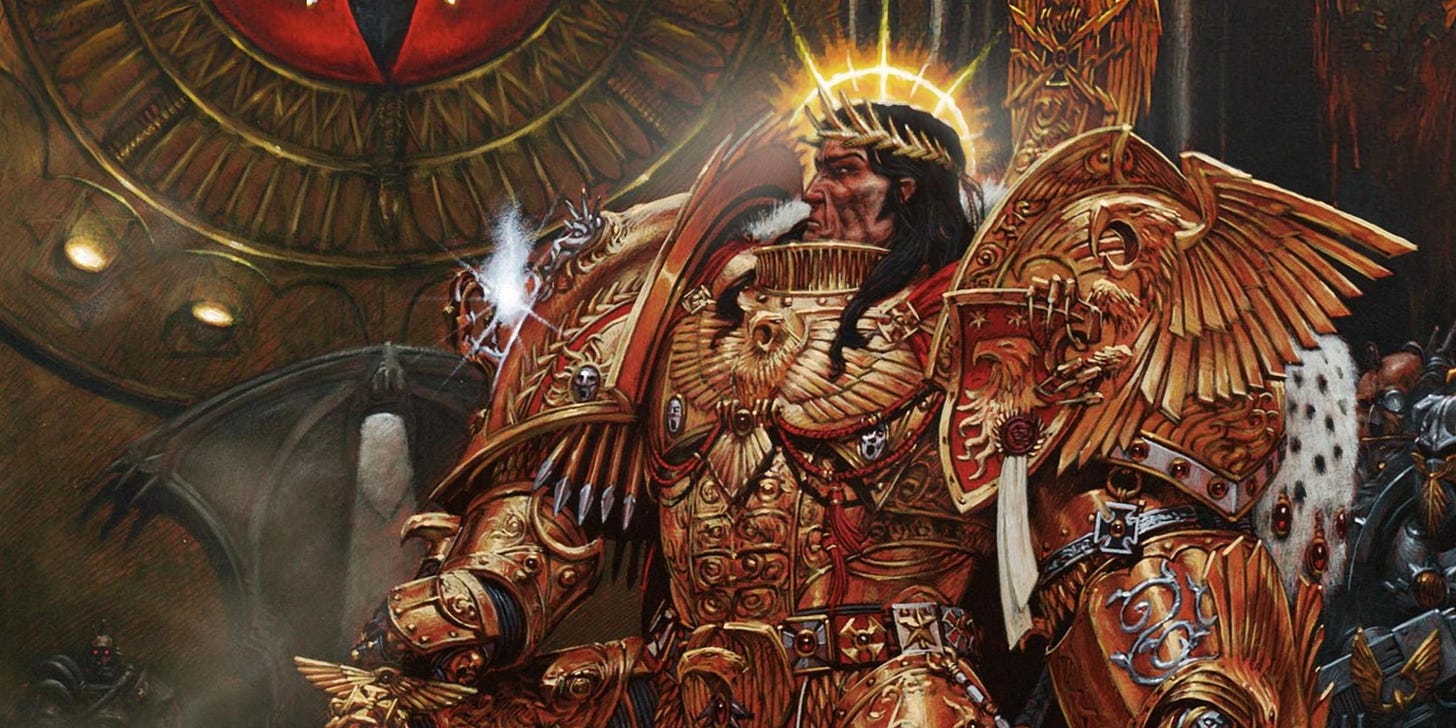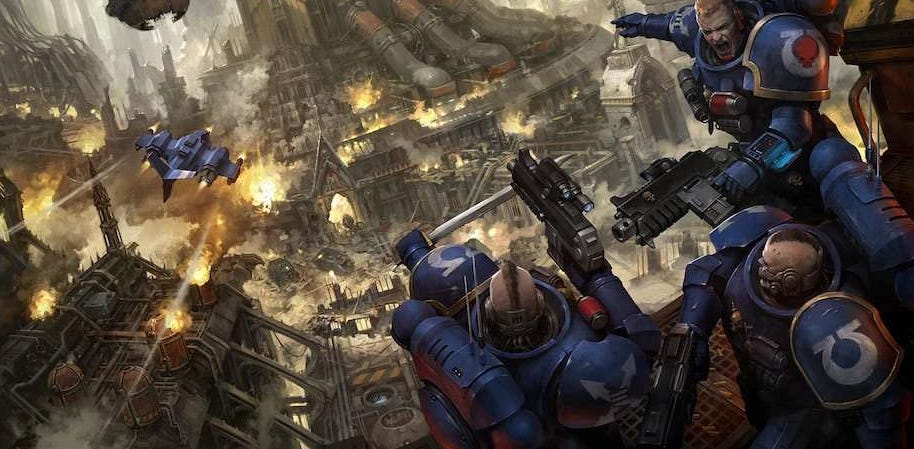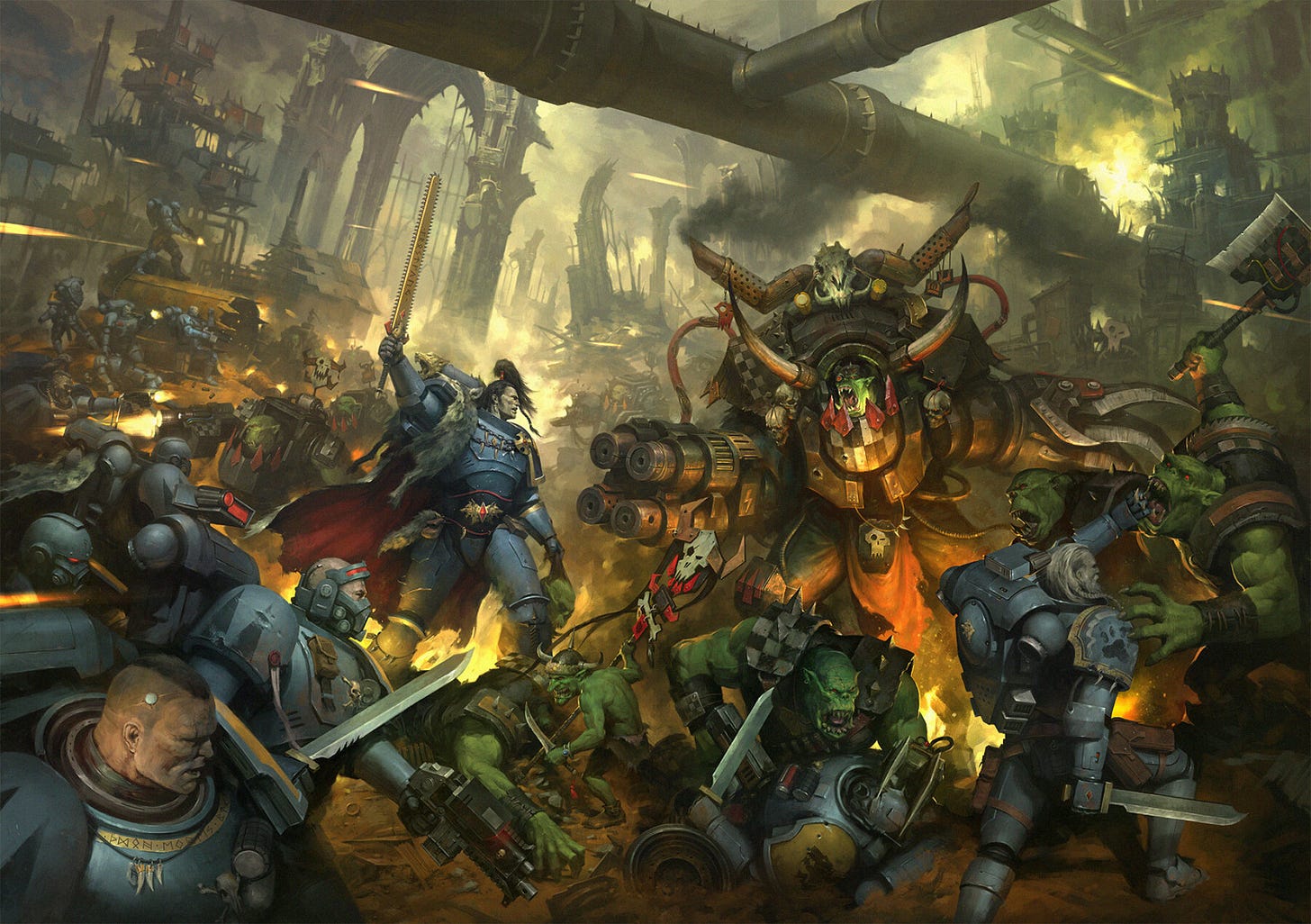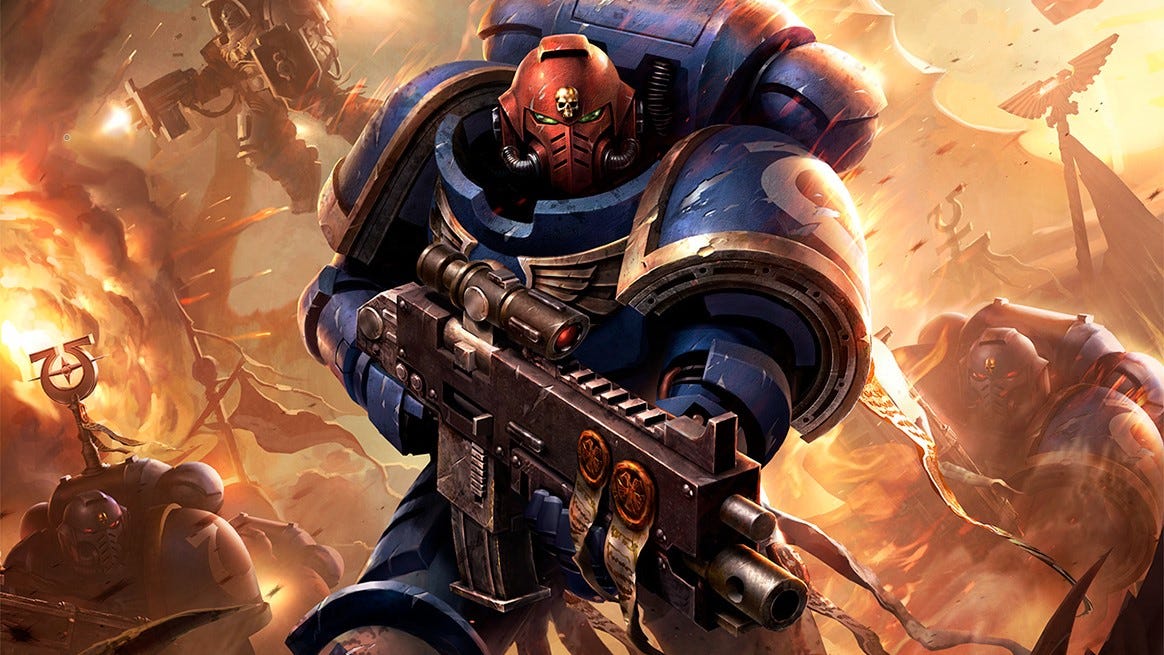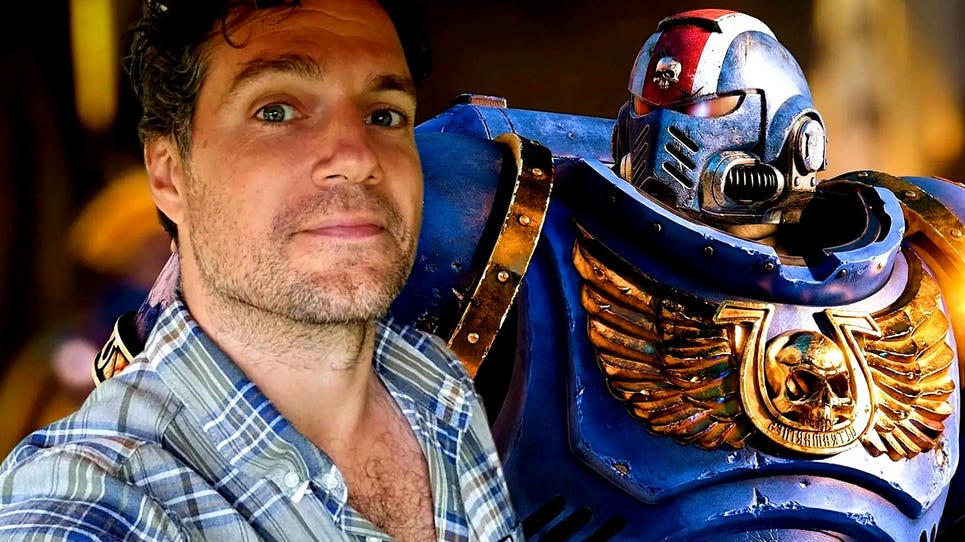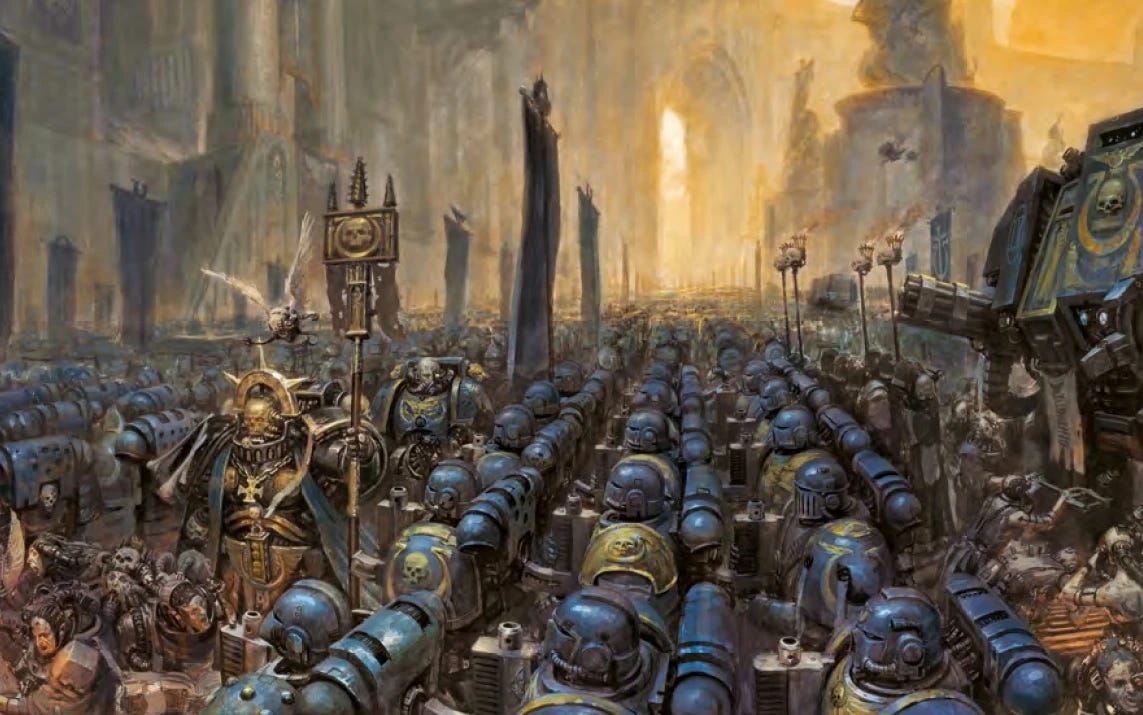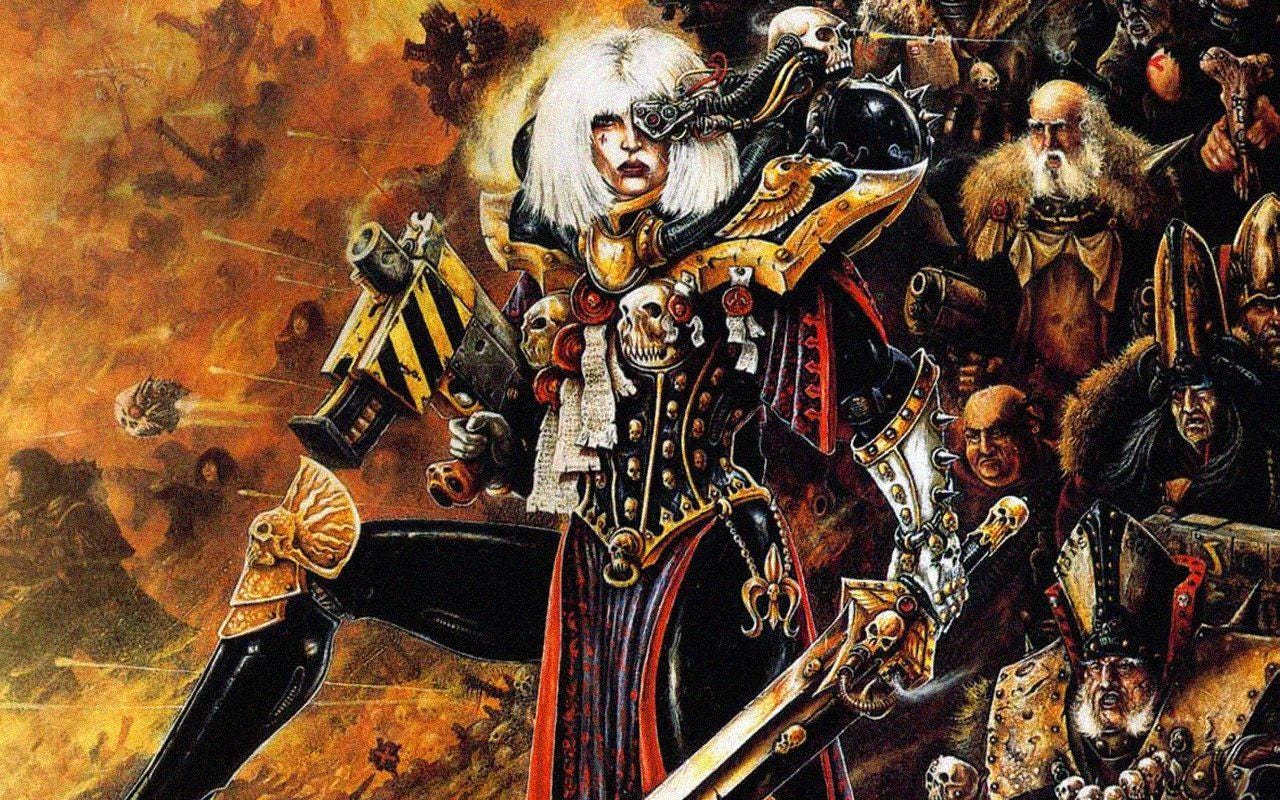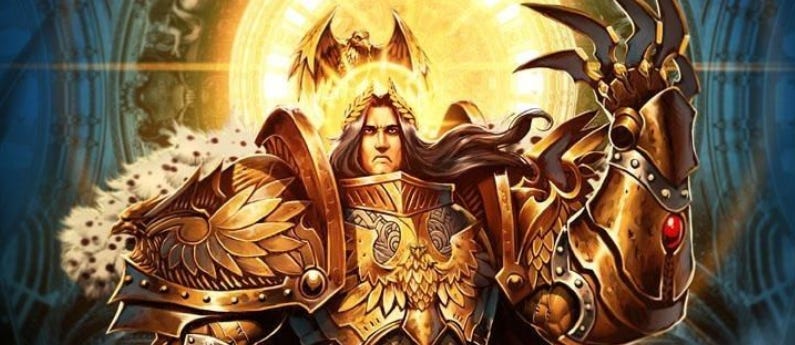WARHAMMER 40K: A New Hard-Edged Myth for the 21st Century?
A New Myth for the 21st Century?
If you’re a guy scrolling through artwork or clips from Warhammer 40K, the hook sinks in fast. Picture this: a dystopian far-future universe where humanity clings to survival by its fingernails, besieged on all sides by cosmic horrors. Armies of hulking, genetically-engineered super-soldiers—think ubermensch in power armor inspired by Ancient Roman aesthetics—storm exotic worlds, mowing down hordes of alien scum with bolters, chainswords, and orbital strikes. Drop-ships scream through toxic skies, unleashing hell on xenos filth. It’s raw, visceral spectacle, the kind that taps straight into that primal urge for epic conflict. If that doesn’t grab you, well, maybe check your pulse. But Warhammer 40K isn’t just eye candy for action junkies; it’s a sprawling beast of a franchise that’s hooked millions, blending tabletop wargaming, novels, video games, and now animations into something that’s as addictive as it is unforgiving. Born in 1987 from Games Workshop as Rogue Trader, it’s evolved into a cultural juggernaut, with sales in the billions and a fanbase that spans generations. The appeal? It’s that perfect mix of strategy, storytelling, and sheer badassery, wrapped in a grimdark package that refuses to pull punches.
For starters, the lore is staggeringly complex, the sort that rivals heavyweights like Dune or Lord of the Rings in depth and scale. Frank Herbert’s Dune gave us a universe of political intrigue, messianic figures, and spice-fueled visions, with elements like the God-Emperor and mutant Navigators that echo straight into 40K’s Imperium of Man. Herbert’s saga explores themes of ecology, religion, and power, much like 40K’s endless crusades against chaos and xenos. Similarly, Tolkien’s Middle-Earth built a mythic history of elves, orcs, and rings of power, complete with ancient languages and epic wars—mirrors you’ll find in 40K’s millennia-spanning sagas, where eldar craftworlds evoke elven realms and ork waaaghs channel orc hordes. But Warhammer cranks it up to eleven, implying a living, breathing galaxy teeming with trillions of beings. Humans huddle under the banner of the Imperium, a theocratic empire ruled from Terra by the corpse-god Emperor, who’s been hooked to a life-support throne for 10,000 years, his psychic light the only thing keeping daemons at bay. Then you’ve got the aliens: brutish Orks who live for scrap and “Waaagh!” energy—a psychic field that makes them tougher the more they fight; elegant but dying Eldar with their psychic craftworlds, navigating the webway to avoid Slaanesh’s hunger; ravenous Tyranid swarms devouring planets like locusts, adapting with every hive fleet; undead Necrons awakening from tombs, their silent kings seeking to reclaim the stars; and the ever-corrupting forces of Chaos daemons spilling from the Warp, twisting souls with mutations and madness. It’s not just a backdrop; it’s a canvas where every faction has layers of history, betrayals, and tech that could fill libraries. The Horus Heresy alone—a civil war that shattered the Imperium eons ago—is a lore rabbit hole with dozens of novels, painting a tragedy of brother against brother on a galactic stage, with primarchs like Horus Lupercal falling to Chaos and loyalists like Rogal Dorn holding the line.
Diving deeper, the setting’s history is a tapestry of cataclysms: the Dark Age of Technology, where humanity reached godlike heights before AI rebellions (Men of Iron) nearly wiped them out; the Age of Strife, with warp storms isolating worlds; and the Great Crusade, where the Emperor unified humanity only for it to fracture in heresy. Each era adds flavor, from archaeotech relics to lost Space Marine chapters. For newcomers, it’s overwhelming, but that’s part of the charm—starting with a codex or novel like “Eisenhorn” by Dan Abnett, which follows an inquisitor hunting heretics, pulls you in with detective-noir vibes amid the grimdark.
If you’re dipping your toes in, start with the visuals—they’re a gateway drug. Catch the Warhammer 40K episode from Amazon Prime’s Secret Level anthology, titled “And They Shall Know No Fear.” It’s a standalone blast following Bladeguard Sergeant Metaurus and his squad charging into Tyranid hell, with voice work from Adewale Akinnuoye-Agbaje and animation that captures the grimdark vibe perfectly. The episode showcases Marines’ unyielding faith, terminating bugs with prejudice while reciting catechisms—it’s pure adrenaline. If you’re a guy, tell me that isn’t one of the coolest pieces of animation you’ve laid eyes on—Space Marines shrugging off wounds that’d pulverize mortals, chanting litanies as they purge the xenos. Then hop to YouTube for Astartes, the fan-made short by Syama Pedersen that’s since gone official under Games Workshop’s wing. It’s a silent, brutal takedown of rebels by Retributor Space Marines, all in under 13 minutes, remastered in 8K for that extra punch. The camera work, sound design—bolters thumping like thunder—it’s cinematic gold. And don’t skip the Astartes 2 teaser trailer—it’s a hype machine showing more psychic showdowns and marine badassery, with psykers exploding heads and terminators teleporting in. These aren’t fluffy cartoons; they’re raw, atmospheric dives into the setting’s brutality, and they’ve converted skeptics into fans overnight, amassing millions of views and inspiring official content.
ACOLYTES AND HERETICS
Even celebrities can’t resist the pull—take Henry Cavill, Superman himself, who’s an avowed superfan. The guy’s painted minis, geeked out in interviews about his Custodes army (the Emperor’s golden guardians), and is now executive producing a live-action Warhammer 40K series for Amazon Prime, potentially focusing on Eisenhorn or Space Marines. He’s even grinding Space Marine 2 multiplayer, refusing to drop his username to avoid fan swarms, and has teased building a cinematic universe. Cavill’s probably shaking his head at anyone questioning the appeal—it’s right there in the power fantasy of armored demigods defending humanity’s flame against the void, a theme that resonates with his own roles in Witcher and Man of Steel.
Of course, not everyone’s on board. There’s this ridiculous undercurrent of accusations labeling 40K as fascistic smut, often from corners that’d make you raise an eyebrow—like communists clutching their bestiality erotica while decrying the Imperium’s xenophobia. Yes, those people exist, and they’re as hypocritical and awful as they sound. The Imperium is a satirical nightmare—a bloated, ceaseless ultra-military bureaucracy where “In the grim darkness of the far future, there is only war” isn’t hyperbole. It’s meant to be over-the-top horrific, a cautionary tale about the depths of desperation in an unimaginably brutal new age. But the setting’s intrigue lies in its unapologetic darkness, not endorsement. Critics of the setting miss the point: it’s the absurdity and exaggeration that make it compelling, not some hidden agenda. Those critics miss the point: it’s the absurdity and exaggeration—Space Marines as walking cathedrals, orks as football hooligans in space—that make it compelling, not some hidden agenda. It’s grimdark as genre, coined by 40K itself, where everything’s awful, but that’s the fun. In the grim darkness of the far future, you either accept extremes in the effort to stave off extinction or you die. Those are called stakes, and in Warhammer the stakes couldn’t be higher.
VICTORY OR DEATH
At its core, Warhammer 40K thrives on faction-based conflict, a staple in the best fantasy and sci-fi. Think Star Wars— the title screams interstellar clashes between Rebels and Empire, light and dark, with dogfights and lightsaber duels. Lord of the Rings pits men, elves, and dwarves against Sauron’s orc hordes in a battle for Middle-Earth’s soul, with alliances forged in fire. Even Harry Potter weaves rivalries between Hogwarts houses amid a wizarding war, with quidditch matches mirroring faction skirmishes. 40K amps this to galactic proportions: endless skirmishes between diverse factions, each with motives that clash like tectonic plates. The Imperium fights for survival against all odds, Orks for the joy of brawling and looting, Tyranids for biomass to feed the hive mind, Chaos for corruption’s sake and the gods’ favor. It’s a powder keg where alliances are rare and betrayals constant, fueling tabletop battles, books like the Gaunt’s Ghosts series (Imperial Guard vs. Chaos), and games like Dawn of War, where you command armies in real-time strategy carnage.
The universe is unabashedly cruel, a nihilistic grind where individual lives are chaff in the cosmic mill. Planets burn in exterminatus orders, billions perish in forgotten campaigns, and hope’s a flickering candle in the void. Servitors—lobotomized humans turned into drones—embody the dehumanization, while hive cities stack billions in squalor under spires of the elite. But here’s the genius: the ceaseless warfare signals that glimmer of defiance. The Imperium’s unfettered commitment to conflict—purging heretics, xenos, and mutants with inquisitorial zeal—stems from a belief they can win, that the future’s worth the blood price. It’s strangely inspiring, especially in a real world where faith in institutions or progress feels eroded. That magnitude of conviction drives the storylines, turning grimdark into something motivational—heroes like Commissar Yarrick facing down orks, or the Last Chancers’ penal legion redeeming through suicide missions.
Zoom in on the human side, and the Imperium of Man’s sub-factions shine like sports teams rallying fanbases. The Adeptus Astartes, or Space Marines, splinter into chapters like the stoic Ultramarines (blue-armored tacticians from Macragge, following the Codex Astartes), ferocious Space Wolves (Viking-inspired berserkers from Fenris, with wolf mounts and rune priests), or gothic Blood Angels (vampiric warriors battling the Black Rage curse). Each has heraldry, histories—like the Salamanders’ forge-craft or Iron Hands’ cybernetic augmentations—and rivalries that fans obsess over, much like NFL teams with stats, legacies, and drama. Then there’s the Astra Militarum (Imperial Guard), everyday grunts holding the line with lasguns and tanks; the tech-priests of the Adeptus Mechanicus worshiping the Omnissiah, questing for lost tech; or the fanatical Sisters of Battle purging with flame and faith, their orders like the Argent Shroud specializing in silent assaults. Picking a sub-faction feels personal, building loyalty akin to rooting for your hometown squad, with forums debating chapter strengths like sports analysts.
This taps into men’s wired interests: compartmentalization, organization, competition, and warfare. The property started as wargames—strategic tabletops where you deploy minis, roll dice, and outmaneuver foes, with editions evolving from 1st to 10th, adding rules for flyers or psykers. Fans dive deep, memorizing chapter tactics, enemy weaknesses, and lore tidbits the way sports nuts track player stats, team histories, stadium quirks, and behind-the-scenes gossip—from trade deadlines to scandals. There’s an analogous thrill in mastering the vast host of knowledge—characters like Roboute Guilliman (Ultramarines primarch, back from stasis to lead Indomitus Crusade), settings from hive cities like Necromunda to daemon worlds in the Eye of Terror, and rumors of plot twists like the Emperor’s true state or Alpharius’ loyalties. It’s a mental battlefield, rewarding strategy and obsession, with painting minis adding a creative layer—custom schemes for your army, like Death Guard in rusted green or Tau in high-tech white.
Warhammer 40K’s appeal boils down to that perfect storm: over-the-top action, labyrinthine lore, and a universe where hope flickers amid endless war. It’s not for everyone—some balk at the grimness or miss the satire—but for admirers, it’s a playground of epic stakes. In a media landscape bloated with reboots and safe bets, 40K stands unapologetic, a reminder that good things, like defiant empires, endure through sheer bloody-mindedness. If it ain’t broke—brutal and bold—why fix it? Dive in, peel the layers, and see if the Emperor protects.
Are you a fan of Warhammer? If so, why?
SARJ OUT



